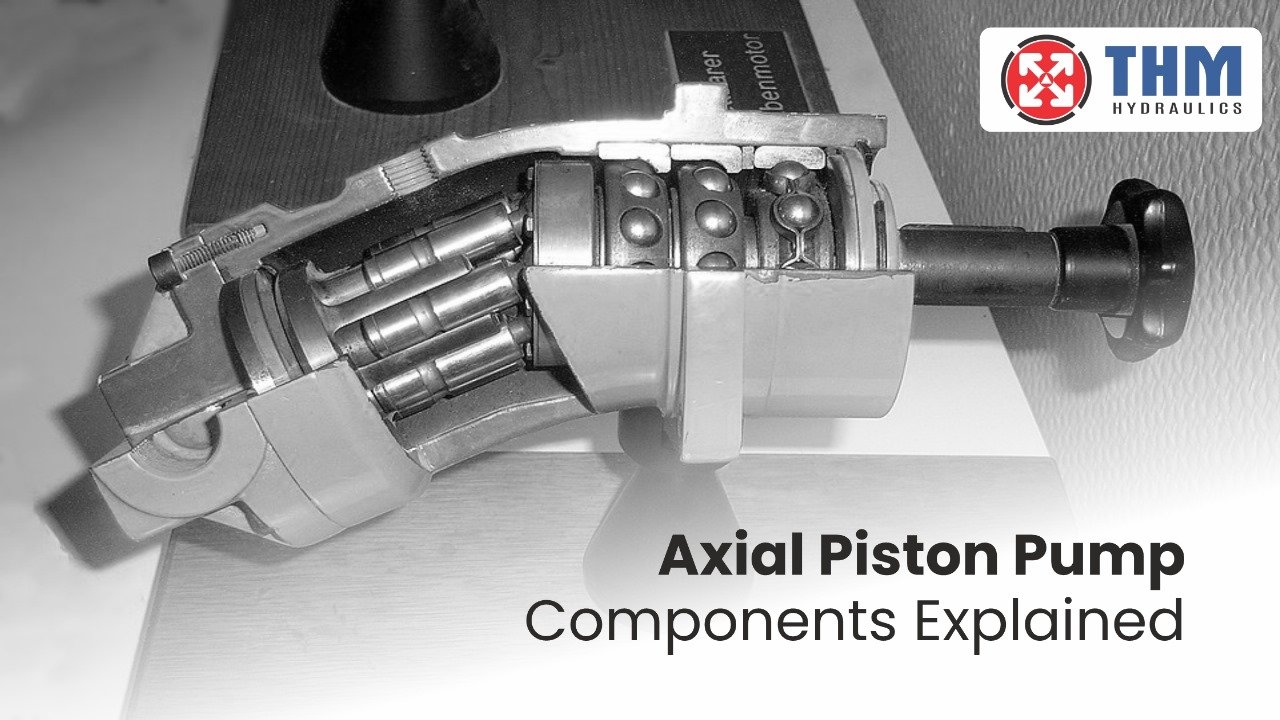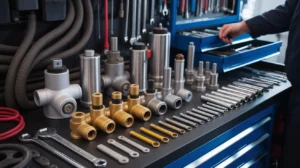Axial piston pumps are key to modern hydraulic systems because they transmit fluid power efficiently. For mobile machinery, industrial automation or construction equipment, it is necessary to understand the workings of an axial piston hydraulic pump and what its parts accomplish.
Common applications include:
- Industrial hydraulic equipment
- Construction equipment that can be used on the move
- Aircraft systems
- Machines that do injection molding
Key Components of an Axial Piston Pump
1. Cylinder Block (Rotor or Barrel)
- Contains a number of piston bores.
- Turns together with the drive shaft.
- In and out movement of pistons pushes the hydraulic fluid in the block.
2. Pistons
- Mostly created with high-strength steel.
- Securely fit inside the cylinder block.
- Their back-and-forth movement pulls in and sends out hydraulic fluid.
3. Swash Plate or Cam Plate
- Can be used to manage the movement of the piston.
- Angle is related to displacement: the larger the angle, the more liquid is moved.
- Both fixed and variable displacement is possible for axial piston variable pumps.
4. Valve Plate
- There are ports for bringing in and removing fluids.
- Keeps its seal, but lets fluid move through it uninterrupted.
5. Drive Shaft
- Moves mechanical force from the motor to the pump.
- Linked to the cylinder block or swash plate.
6. Cylinder (or Retaining) Plate
- Supports the position of the pistons.
- Makes sure the swash plate is always in contact for correct movement.
7. Bias Spring or Control Mechanism
Based on demand, these components in variable displacement axial piston pumps automatically control the flow rate and pressure.
Types of Axial Piston Pumps
Different axial piston pump types are used depending on the job they need to do.
Fixed Displacement Pumps:
- Provide a steady rate of water flow.
- A simple design that is also very durable.
- Suitable for tasks that are always the same and happen repeatedly.
Variable Displacement Pumps:
- The amount of fluid pumped changes with the swash plate’s angle.
- Good for systems that must adjust speed and pressure.
- Used in many energy-efficient applications and today’s industrial machines.
Axial Piston Pump Working Principle
The axial piston pump works by having pistons move back and forth.
1. The rotation of the pump shaft causes the cylinder block to move.
2. The pistons move in the direction the swash plate is angled.
3. When the pistons move away from the swash plate, they pull in hydraulic fluid (during the inlet stroke).
4. When they reach the swash plate, they push fluid out of the pump (discharge stroke).
5. Regular rotation of the pump guarantees that hydraulic fluid is supplied to the system smoothly.
With this principle, the pump can handle high pressure and keep a steady output which is why it’s good for axial piston pumps in hydraulic systems.
Guidelines for Choosing the Right Axial Piston Pump
When you are looking for an axial piston pump, keep these things in mind:
- Before applying, make sure you know the system’s flow and pressure demands.
- Select the type of control depending on how much you want to change and how energy efficient you wish to be.
- Check that the pump materials will not react with your chosen hydraulic fluid.
- Choose pumps that are designed so their parts can be replaced easily.
- Check if the manufacturer can provide you with help and spare parts close to you.
Advantages of Axial Piston Hydraulic Pumps
- Can handle high pressures, up to 400 bar or more.
- Compact form: Ideal for both mobile and industrial work.
- Variable control helps save energy when needed.
- Long-term use is possible if the equipment is maintained.
Common Applications
Many applications use axial piston pumps because they are reliable.
- Earth moving machines and excavators
- CNC machines
- Marine hydraulics
- Wind turbines
- Injection molding machines
Because of their excellent performance, they are vital in modern hydraulic systems.
Final Thoughts on Axial Piston Pump Components
Knowing how an axial piston pump works allows you to choose, manage and maintain it properly. Each part such as the swash plate and the cylinder block and pistons, contributes to the overall performance of the engine.
If you are looking for an upgrade for your industrial setting or a reliable axial piston hydraulic pump in India, consider THM Huade for their high-quality options. Always look at how efficient the pump is, its pressure rating and if it can work with your system.
When energy efficiency and performance are important, the axial piston pump is still a top choice for modern hydraulic systems.
FAQs:
The flow of fluid in an axial pump goes the same direction as the pump shaft. It is most often employed in situations where a lot of water is needed and pressure is not a concern such as for circulation or irrigation.
Axial flow gives high flow rates at a low cost in terms of resistance. Moving large quantities of fluid over short distances is very efficient with pumps.
Axial piston pumps may be designed to have a fixed or variable amount of displacement. Fixed types guarantee a steady flow, but variable types change the flow as needed by the system.
Axial flow causes fluid to move parallel to the pump shaft as the blades or pistons rotate, allowing the pump to work steadily and efficiently.



